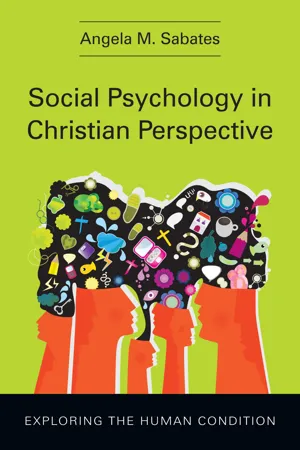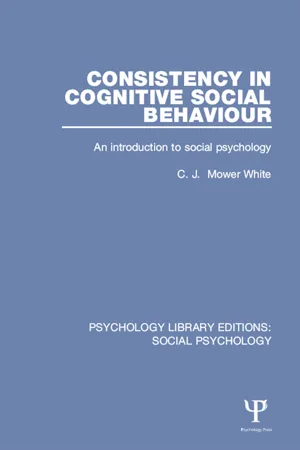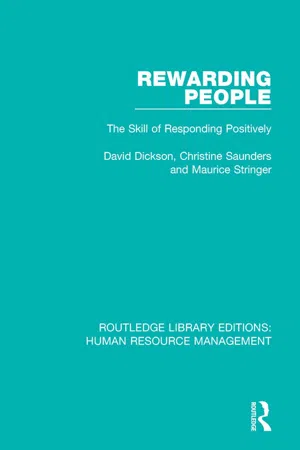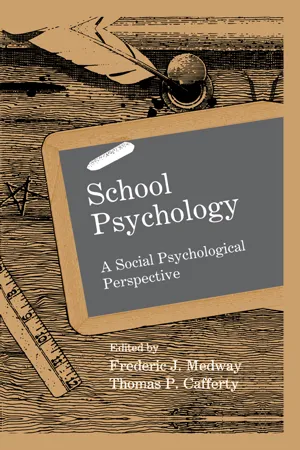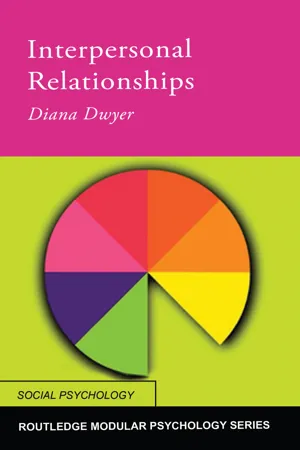Psychology
Interpersonal Attraction
Interpersonal attraction refers to the positive feelings and attitudes that individuals have toward one another. It encompasses factors such as physical attractiveness, similarity, proximity, and reciprocity. This concept is central to understanding the formation and maintenance of relationships, as well as the dynamics of social interactions.
Written by Perlego with AI-assistance
Related key terms
10 Key excerpts on "Interpersonal Attraction"
- eBook - ePub
Applied Social Psychology
Understanding and Addressing Social and Practical Problems
- Jamie A. Gruman, Frank W. Schneider, Larry M. Coutts(Authors)
- 2016(Publication Date)
- SAGE Publications, Inc(Publisher)
In the next section, we consider the topic of Interpersonal Attraction, including what it means to feel attracted to specific others and some of the major determinants of attraction, such as proximity, familiarity, and physical attractiveness. In infancy, the process of attachment (the focus of the third section) might become our blueprint for developing later adult intimacy. The final section covers the selection process, which explores the qualities and experiences that draw us to others, what makes others seem attractive, and how we become closer. Circumstances sometimes throw people together. Simply enrolling in the same class as someone else, or happening to sit beside him or her can prompt interaction and liking, eventually friendship, and even love. Social psychology offers several principles to account for such transformations. The most consistent lesson of social psychology is the power of situational influences (see Chapter 1). Circumstances affect you. You live your life in a social context, considering and reacting to the events and conditions surrounding you. In human experience, thoughts, feelings, and actions are shaped, at least in part, by the social environment. Someone you run into frequently becomes more familiar—and more likable. Chris and Lee were pushed together by common circumstances (a small campus, the same class), and pulled together by mutual interests (perceiving common preferences in pastimes, developing shared friendships). Once attracted, they selectively perceived what they liked in each other and downplayed their differences. For example, Chris saw Lee as socially confident and skilled; only later did Chris recognize that Lee too had needs for reassurance and social acceptance. In addition to individual differences and personality characteristics (the subject matter of personality psychology), their fate is also shaped by situational influences and the social perceptions they support - eBook - ePub
Social Psychology in Christian Perspective
Exploring the Human Condition
- Angela M. Sabates(Author)
- 2012(Publication Date)
- IVP Academic(Publisher)
Interpersonal Attraction and Relationships Who Likes Whom and When and Why? If you love those who love you, what credit is that to you? For even sinners love those who love them. . . . Love your enemies, do good. LUKE 6:32, 35The Relevance of Relationships and Interpersonal Attraction
How people become attracted to one another is perhaps one of the most popular topics for university students to explore. As Klohnen and Luo (2003) note, why we are attracted to some individuals more than others is one of the fundamental human dilemmas. After all, these initial attractions have important implications for decisions about those with whom we are most likely to form long-lasting relationships. And, as Bowlby (1989) noted, these sorts of attachments are an important ingredient of human experience “from the cradle to the grave.” Berscheid (1985) likewise noted the importance of relationships that result from Interpersonal Attraction. He found that when people were asked what makes their life meaningful, most of the answers referred to close relationships with family and friends as well as romantic partners. Thus, this subject certainly has relevance for everyday life.Social psychologists are interested in much more than just what attracts people to each other for a date on Saturday night (albeit an important topic in its own right!). The term Interpersonal Attraction is used in a much broader sense to include how people are drawn to one another in different sorts of interactions or relationships: whether romantic, friendship or fleeting encounters.As you have seen throughout this text, different sorts of social relationships and the factors that impact them are of primary concern to social psychologists. For instance, research on social perception helps us understand how the ways in which we perceive others affect our desire to form relationships with them. Likewise, research on group behavior investigates both the power of the relationships within groups as well as the relationships between groups. Helping - eBook - ePub
Consistency in Cognitive Social Behaviour
An introduction to social psychology
- C.J. Mower White(Author)
- 2015(Publication Date)
- Psychology Press(Publisher)
4 Interpersonal Attraction 1 IntroductionIt is apparent that among the most important aspects of our world are other people: they provide us with friendship, love, happiness and other positive experiences, and also with negative experiences such as disliking, hate, pain and unhappiness. It is therefore to be expected that we will have learned to make judgments about those people with whom we come into contact. Frequently these judgments will include a descriptive element as well as an evaluation; such judgments are called, by social psychologists, ‘attributions’, and have been considered in Chapter 3 ; this chapter will consider another type of judgment, the kind which is often described in terms of liking or friendship and their opposites. Psychological studies of Interpersonal Attraction have mainly concerned bonds between people based upon liking or friendship (how they are formed, for example, or what factors influence them). Some workers have included within this topic studies of romantic love, but since the theoretical explanations which are applicable to liking and friendship can seldom be applied to romantic love (see, for example, Berscheid and Walster, 1974; Rubin, 1970, 1973), this aspect of attraction will not be considered in this chapter, except for brief mentions in instances where it has influenced studies of friendship formation.Theories of attraction can be divided into those that stem from the principle of consistency (e.g. Heider, 1958; Newcomb, 1953), and those that invoke explanations in terms of behaviourism and reinforcement principles (e.g. Byrne, 1961a; Thibaut and Kelley, 1959). This chapter discusses these two types of theory in turn; it also deals with the factors influencing attraction as they appear most relevant to the theories, and concludes with a comparative evaluation of the two approaches to the explanation of Interpersonal Attraction. - eBook - ePub
Rewarding People
The Skill of Responding Positively
- David Dickson, Christine Saunders, Maurice Stringer(Authors)
- 2017(Publication Date)
- Routledge(Publisher)
Chapter 6Interpersonal Attraction and rewardINTRODUCTIONWe have seen how various verbal and nonverbal features of interpersonal behaviour, acting as social rewards, can have a significant impact on what the interactive partner does and, in more global terms, not only determine perceptions of warmth and empathy, but also make a beneficial contribution to outcomes in counselling, therapy and education. Additionally, the giving and receiving of rewards have also been associated with the establishment of Interpersonal Attraction. It is to this topic that we now turn.Social interchange which is rewarding can have the effect of establishing positive attitudes between interactants which in turn can lead to lasting friendship and even love. We are often attracted to those who react positively to us. The first part of this chapter will examine three factors which are considered to be instrumental in attempting to explain attraction between people: physical attractiveness, attitude similarity and complementarity, and personality. In addition, it can be shown, from a review of studies devoted to the phenomenon, that, firstly, an individual deemed ‘attractive’ is more likely to obtain rewards from others and, secondly, that an individual’s ‘attractiveness’ can be a source of reward to others. The remainder of the chapter focuses upon the research and application of ideas about attraction in some of the applied professions. It is important to bear in mind that the intention is not to provide a litany of research findings on the topic (see Byrne, 1971 and Berscheid, 1985 for extensive research reviews), but rather a brief account of some of the central features of it and an overview of key research findings in three distinctly different contexts, namely teaching, counselling and the law. While some reference will be made to attraction as a feature in the initial stages of forming a relationship, a more detailed consideration of relationships and the contribution of rewards to them will be left to Chapter Nine. - eBook - ePub
- Nicky Hayes(Author)
- 2017(Publication Date)
- Routledge(Publisher)
We can see, then, how the processes of person perception draw on our existing knowledge and beliefs, but often seem to have relatively little to do with the actual person that we are perceiving. As we get to know the other person more closely, we begin to build up a store of knowledge about them. If we are motivated to do so, we will gradually revise our ideas to develop a more realistic picture of what they are like. In many cases, though, our initial perceptions mean that we simply don’t take the trouble to get to know that particular person, so we continue to apply superficial impressions or negative stereotypes to them. One of the factors which can make the difference between whether we take the trouble to know someone better or not is whether we find them attractive, so we will go on in this chapter to look at the psychology of attraction.ATTRACTION
Being social inevitably involves interacting with other people, but in our everyday experience, we like some people and don’t like others. Sometimes, too, we find ourselves particularly attracted to someone.Key TermsAttractionisn’t just about our close or intimate relationships; it affects our working relationships and friendships too. We prefer to spend our time with people that we like, and to avoid people who we find unattractive for one reason or another. We like working with some people and not others. We will take problems or things we want to discuss to certain people, but not to others.The experience of feeling drawn towards another person, as a positive aspect of interpersonal experience.attractionIt makes a difference to how we judge people, too. Alicke and Zell (2009) found that social attractiveness had a significant influence on our attributions of blame. They asked participants to consider a legal scenario about a trial of a man who had tried to intervene in what he believed to be an aggressive argument between a man and a woman, and had accidentally punched the woman while trying to restrain the man, resulting in significant harm. The information they were given about the man either presented him as socially attractive or as unattractive; and this information significantly affected how much the participants judged the man as being to blame for the incident. - eBook - ePub
School Psychology
A Social Psychological Perspective
- Frederic J. Medway, Thomas P. Cafferty, Frederic Medway, Frederic J. Medway, Thomas P. Cafferty, Frederic Medway(Authors)
- 2013(Publication Date)
- Routledge(Publisher)
Because attraction and friendship formation among group members is an everyday social occurrence, it should not be surprising to find that social psychologists have a history of studying Interpersonal Attraction, friendship and group formation, and the socialization processes that occur in groups. This chapter reviews and overviews much of that research as we discuss how social psychologists have studied Interpersonal Attraction as well as the implications of social psychological research for education professionals.Social psychologists have brought several orientations to the study of attraction. First, they have tried to look at processes occurring within individuals (i.e., at the intraindividual level), particularly at how individuals react to cues from others such as dress, attractiveness, body posture, attentiveness, and so on (e.g., Berscheid & Walster, 1978; Maruyama & Miller, 1981). This literature has been called research on impression formation. Second, they have looked at interpersonal or interindividual behaviors, namely, how an individual’s reactions to another person affect the latter person’s reactions to the first person (e.g., Snyder, Tanke, & Berscheid, 1977), as well as how long-term interactions among individuals affect earlier impressions (e.g. Snyder & Swann, 1978). Third, they have looked beyond individuals to groups, studying, for example, the pressure that groups put on individuals as well as the ways that groups exert pressure (Asch, 1952; French & Raven, 1959). This work in particular has been tied to schools, for it provided one model to guide school desegregation (e.g., Maruyama, Miller, & Holtz, 1986). Fourth, they have looked in detail at the development and consequences of peer relationships (e.g., Hartup, 1983). In effect, a number of complementary approaches have combined to provide a broad perspective for viewing Interpersonal Attraction and interpersonal relationships in group settings. This chapter tries to summarize those approaches, beginning with a discussion of the importance of Interpersonal Attraction.Importance of Interpersonal AttractionFirst, Interpersonal Attraction can aid in processes of socialization. Socialization occurs in families, in church and community groups, in neighborhoods, and in schools; because the present volume is oriented to issues of school psychology, we focus on socialization in schools. Educators have described a number of important functions that schools serve beyond teaching academic skills. Socialization, acculturation, and value transmission are prominent examples. These functions often have been addressed implicitly and given labels like the hidden curriculum - eBook - ePub
- Richard Gross, Rob McIlveen(Authors)
- 2016(Publication Date)
- Routledge(Publisher)
et al. (1983) define interdependence as a context in which one person’s behaviour, emotions and thoughts affects the other. This section discusses theories that attempt to account for the development of close relationships. The most important rules of friendship (Argyle and Henderson, 1985) are offering help to a friend in need, respecting a friend’s privacy and keeping confidences and operating in a climate of mutual trust.Figure 7.5: Effect of interaction on attraction. Adapted from Smith and Mackie (1995)Figure 7.6: The inter-linked effects of similarity, interaction and likingSocial psychologists have attempted to account for the development and maintenance of close relationships by proposing a number of theories that claim to account for attraction between individuals. Three of these, reinforcement theory, social exchange theory and equity theory are discussed below. In addition, the importance of self-disclosure is outlined.7.4.1 Reinforcement theoryA number of explanations for attraction have been culled from learning theory, the simplest being that we like people who are present when we receive a reward, since this reward provides positive reinforcement for us (Lott and Lott 1972). Byrne and Clore (1970) have presented the reinforcement-affect model where the reinforcement part refers to the idea that we like people who provide us with rewards and dislike those who punish us. Affect refers to the emotional component that arises as a result of reinforcement. The model has its basis in classical conditioning, and proposes that we can associate another person with positive (rewarding) features present in the environment at the same time. For example, if you go to a party that is particularly good fun, you will associate positive features arising from the party environment with people present at the party. Figure 7.7 - eBook - ePub
- Diana Jackson-Dwyer(Author)
- 2013(Publication Date)
- Routledge(Publisher)
3 Determinants of Interpersonal Attraction What this chapter will teach you • The main factors that determine with whom we make friends and form romantic relationships. • Why each of these factors is important. • Whether opposites attract or birds of a feather flock together. • Whether the internet has changed the way in which relationships are formed. In our everyday lives we meet a multitude of people but only form lasting relationships with a few. On what basis do we choose our friends and romantic partners? In this chapter, we consider research findings into the factors that help determine the onset of friendship or romance and the reasons why these factors may be influential. Proximity Proximity is a powerful force in Interpersonal Attraction; indeed probably the best predictor of whether two people will become friends is how far apart they are. Because of where people live, sit in a classroom or earn a living they have close contact with particular people, and it is this physical arrangement that is hugely influential in determining friendship patterns. In a classic study, Festinger et al. (1950) observed the friendships that formed in a block of apartments for married students consisting of seventeen separate buildings, each comprising ten flats on two floors. More than ten times as many friendships formed between students who shared the same building than between students in different ones. Within the same building, friendships were far more likely between people who lived on the same floor than between those on different floors. It was not only physical distance that made a difference: the most popular people were those who had apartments nearest the staircases and postboxes. This indicates that the functional distance, that is, the likelihood of two people coming into contact, is also very influential. In fact, as this study demonstrates, architectural features can significantly affect the likelihood that people will make friends - eBook - ePub
Conceptual Metaphor in Social Psychology
The Poetics of Everyday Life
- Mark J. Landau(Author)
- 2016(Publication Date)
- Routledge(Publisher)
In the early stages, people are initially choosing others with whom to form a relationship, whether it be a friendship or a romantic coupling. Research indicates several determinants of Interpersonal Attraction, including propinquity and attitude similarity, and my intent is not to consider them in full. It’s to enrich the overall picture by considering some metaphoric influences on who we like and why we like them.Attractive QualitiesAsked why they like (or dislike) someone, people typically cite that person’s attributes. We are drawn to people who have talents, remind us of positive experiences, or who have achieved things that our culture values (Fletcher, 2000). We also like people with certain personality traits, including friendliness, honesty, warmth, intelligence, sense of humor, emotional stability, ambition, openness, and extraversion (Sprecher & Regan, 2002). These and many other intangible qualities are commonly talked about metaphorically—indeed, terms like stability and openness wear their metaphoric meaning on their sleeve.While that’s not news, research suggests that something deeper and more interesting also occurs. It seems that the perception of others’ qualities follows the contour of metaphor, even when linguistic expressions are not salient. The reasoning behind this research is this: If perceptions of traits are grounded in concrete experiences, then enacting or simulating those experiences (via sensation, motor activity, or perceptual imagery) should transfer over to change trait perceptions in metaphor-consistent directions.For example, cuing spatial verticality by presenting information at high positions on a computer screen led participants to perceive others as higher in power and status (Chapter 2 )—two traits that matter when assessing the value of potential relationship partners. Meier and Dionne (2009) extended these findings to physical attraction. They built on theories positing that (heterosexual) men and women evolved to have different, specialized preferences in their mates that favor the conception and survival of their offspring (Buss, 1994). Women evaluating potential mates prefer men who present themselves as assertive, confident, and dominant (Gangestad, Garver-Apgar, Simpson, & Cousins, 2007; Macrae, Alnwick, Milne, & Schloerscheidt, 2002). Men, in contrast, gravitate toward women who are less dominant—for example, those who are younger and shorter than themselves and whose facial features resemble to some extent those of a baby. Meier and Dionne tested whether people use verticality information as an implicit cue to power when rating the attractiveness of opposite-sex individuals. They found that women were more attracted to men when their pictures were presented near the top of a computer screen, whereas men favored women whose pictures appeared in a low position. Hot or not has its ups and downs - eBook - ePub
- Diana Dwyer(Author)
- 2013(Publication Date)
- Routledge(Publisher)
4 Theories of Interpersonal AttractionLearning theory Social exchange theory Equity theory Sociobiology In Chapter 3 we saw that certain factors, in particular proximity, similarity and physical attractiveness, are important in the formation of friendship and romantic relationships. In this chapter we will explore some of the theories that seek to explain why these and other factors may be of importance in the formation, maintenance and perhaps dissolution of such relationships.Learning theory
Byrne and Clore (1970), in their reinforcement-affect theory, argue that both classical conditioning and operant conditioning help to forge friendships and romantic liaisons. Classical conditioning involves learning by association, so that a neutral stimulus produces an emotional response. We may learn to associate the sound of a dentist’s drill with fear, even though the sound has never hurt us. Operant conditioning involves learning by consequences, so that we are more likely to do things that are reinforced and less likely to do things that that are punished.The effect of classical conditioning on liking
In terms of classical conditioning, we like people with whom we associate enjoyment and satisfaction, even if they are not directly responsible for these positive experiences. If we meet people under pleasant circumstances, such as seeing them regularly at our local pub, we are more likely to be attracted to them than to those whom we meet under disagreeable situations such as at a tedious series of committee meetings. Evidence to support this is offered by a study by Veitch and Griffith (1976), who demonstrated that people who interacted with a stranger against a background news programme of all good news rated the stranger more positively than those interacting with a stranger while listening to a news broadcast full of depressing news items.
Index pages curate the most relevant extracts from our library of academic textbooks. They’ve been created using an in-house natural language model (NLM), each adding context and meaning to key research topics.

